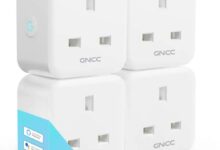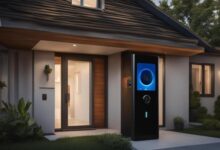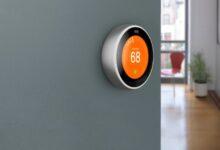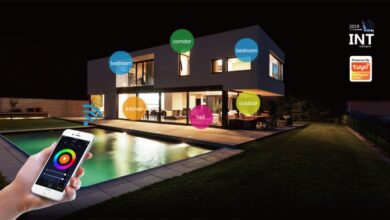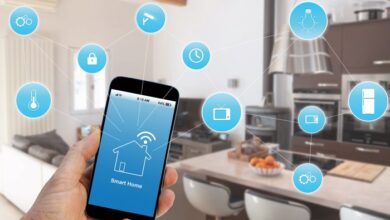Voice-Controlled Home The Future of Living
Voice-Controlled Home: Imagine a world where your home anticipates your needs, responding to your every command with seamless ease. This isn’t science fiction; it’s the rapidly evolving reality of smart home technology. From adjusting the thermostat with a simple voice command to locking the doors remotely, the possibilities are both exhilarating and transformative. We’ll delve into the technology, the security implications, and the exciting future of this increasingly integrated lifestyle.
This exploration will cover the essential hardware and software components, navigating the intricacies of setting up a voice-controlled system, and addressing crucial privacy concerns. We’ll also examine the diverse applications, from enhancing accessibility for individuals with disabilities to optimizing energy efficiency and creating personalized entertainment experiences. The journey will uncover both the immense potential and the inherent challenges in this rapidly advancing field, offering a comprehensive understanding of the voice-controlled home landscape.
Defining the Voice-Controlled Home Experience
The voice-controlled home represents a significant leap forward in home automation, promising a seamless and intuitive interaction between residents and their living space. This technology aims to simplify daily routines, enhance accessibility, and ultimately create a more comfortable and efficient home environment. The ideal experience hinges on a combination of accurate voice recognition, intelligent task management, and a user-friendly interface.The ideal user experience in a voice-controlled home should feel natural and effortless.
Imagine waking up and simply saying “Good morning,” to trigger a cascade of actions: the lights gradually brighten, your favorite playlist starts playing, and the coffee maker begins brewing. This level of personalized automation requires sophisticated understanding of user preferences and contextual awareness. The system should anticipate needs and proactively offer relevant assistance, minimizing the need for explicit commands.
Voice Assistant Task Capabilities
A comprehensive voice assistant for the home should handle a broad spectrum of tasks. This includes controlling lighting, temperature, and appliances; managing security systems; playing music and podcasts; providing information (weather, news, traffic); setting reminders and alarms; making calls and sending messages; and integrating with other smart home devices. Beyond these basic functionalities, advanced systems could manage shopping lists, schedule appointments, and even offer personalized recommendations based on user behavior and preferences.
For instance, a system could learn that you prefer a specific coffee blend and automatically reorder it when supplies are low.
Comparison of Voice Assistant Platforms
Several platforms dominate the smart home voice assistant market, each with its strengths and weaknesses. Amazon’s Alexa boasts a vast library of skills and integrations, making it highly versatile. Google Assistant, known for its robust search capabilities, excels at providing information and completing complex tasks involving multiple services. Apple’s Siri, deeply integrated into the Apple ecosystem, offers seamless control for users within that environment.
The choice of platform often depends on existing smart home devices and personal preferences. For example, a user heavily invested in the Apple ecosystem might find Siri’s integration the most appealing, while someone with a mixed bag of devices might favor Alexa’s broad compatibility.
Typical Voice-Controlled Home User Persona
Let’s consider “Sarah,” a 38-year-old professional with two young children. Sarah values convenience and efficiency. She uses her voice-controlled home system to manage her busy schedule, control the home environment for her children’s comfort, and ensure home security. Sarah is technologically savvy but prefers simplicity and ease of use. She is not interested in complex configurations or extensive customization.
This persona highlights the need for intuitive interfaces and user-friendly design that cater to a broad range of technical skills and personal preferences. Other user personas might emphasize different needs, such as accessibility for individuals with disabilities or enhanced security features for elderly users.
Voice-Controlled Home System User Interface Flowchart
A simplified flowchart would illustrate the typical interaction. The user initiates a voice command. The system processes the command using speech recognition technology. The system then interprets the command, identifying the intent and the relevant devices or services. The system executes the command, controlling the designated devices or accessing the required information.
Finally, the system provides feedback to the user, either verbally or visually, confirming the action. This process highlights the critical role of accurate speech recognition, intelligent interpretation, and effective feedback mechanisms in creating a seamless and reliable user experience. More complex interactions would involve additional steps, such as user authentication or decision-making based on contextual information. For example, if the user asks to “turn on the lights,” the system might consider the time of day and adjust the brightness accordingly.
Technology and Infrastructure of Voice-Controlled Homes
Stepping into the world of voice-controlled homes requires understanding the intricate interplay of hardware, software, and communication protocols. This technology isn’t just about convenience; it represents a significant shift in how we interact with our living spaces, offering accessibility and automation previously unimaginable. This section delves into the technical foundations underpinning this exciting evolution.
Hardware Components for Voice-Controlled Homes
A functional voice-controlled home hinges on several key hardware components. These components work together seamlessly to capture your voice commands, process them, and execute actions within your home environment. The core components typically include a smart speaker or digital assistant device, a robust home network, and a range of smart home devices capable of responding to voice commands.
Without these elements, the system remains incomplete and unable to deliver the promised functionality.
Setting Up a Basic Voice-Controlled Home System
Setting up a basic voice-controlled home is surprisingly straightforward. The process typically begins with choosing a voice assistant, such as Amazon Alexa or Google Assistant. Next, you’ll need to connect your chosen smart speaker to your home Wi-Fi network. Once connected, you can download the corresponding app and follow the on-screen instructions to link the speaker with other compatible smart devices, such as smart lights or thermostats.
This process often involves creating an account and allowing the app to access your home network. Finally, you can begin testing your system by issuing simple voice commands.
Communication Protocols in Voice-Controlled Home Networks
Voice-controlled homes rely on various communication protocols to facilitate seamless interaction between devices. Common protocols include Wi-Fi, Bluetooth, Zigbee, Z-Wave, and Thread. Wi-Fi is ubiquitous for its range and data transfer capabilities, while Bluetooth is ideal for shorter-range connections with lower power consumption. Zigbee and Z-Wave are specialized protocols designed for low-power, mesh networking in smart home applications, enhancing reliability and range.
Thread, a newer protocol, aims to improve the speed and efficiency of smart home networks. Understanding these protocols is key to optimizing network performance and ensuring compatibility among your smart home devices.
Examples of Voice-Controlled Smart Home Devices
The range of smart home devices compatible with voice control is constantly expanding. Popular examples include smart lighting systems (Philips Hue, LIFX), smart thermostats (Nest, Ecobee), smart locks (August, Schlage), and smart plugs (TP-Link Kasa, Wemo). These devices allow for voice-activated control of lighting, temperature, security, and appliance operation. The growing ecosystem of compatible devices offers users considerable flexibility in customizing their smart home experience to fit their specific needs and preferences.
For instance, you could voice-activate your lights to dim at sunset or adjust your thermostat from your couch.
Comparison of Popular Voice Assistant Smart Speakers
| Feature | Amazon Echo (4th Gen) | Google Nest Audio | Apple HomePod mini |
|---|---|---|---|
| Voice Assistant | Alexa | Google Assistant | Siri |
| Sound Quality | Good, with decent bass | Excellent, balanced sound | Compact but surprisingly good sound |
| Smart Home Integration | Extensive, works with many devices | Excellent, integrates well with Google ecosystem | Strong integration with Apple devices |
| Price | Mid-range | Mid-range | Budget-friendly |
Security and Privacy in Voice-Controlled Homes
The increasing popularity of voice-controlled home systems presents a compelling case study in the delicate balance between convenience and security. While these systems offer unparalleled ease of use, they also introduce new vulnerabilities and privacy concerns that require careful consideration and proactive mitigation strategies. Understanding these risks and implementing robust security measures is crucial for safeguarding both personal data and home security.
Voice-controlled homes rely on constant data collection to function. This data, ranging from simple voice commands to more complex contextual information, is inherently sensitive and potentially exploitable. The potential for misuse extends beyond simple eavesdropping, encompassing identity theft, unauthorized access, and manipulation of smart home devices. This necessitates a comprehensive approach to security that prioritizes both technical safeguards and user awareness.
Potential Security Vulnerabilities in Voice-Controlled Home Systems
Voice-controlled home systems, while convenient, are susceptible to various security breaches. These vulnerabilities can stem from weaknesses in the system’s software, network infrastructure, or even the devices themselves. For instance, poorly secured Wi-Fi networks can provide entry points for malicious actors to intercept voice data or gain control of connected devices. Similarly, vulnerabilities in the system’s software can be exploited to execute malicious code or gain unauthorized access to user data.
A real-world example is the vulnerability discovered in a popular smart speaker that allowed hackers to remotely activate the device’s microphone and listen in on conversations. This highlights the importance of regularly updating software and firmware to patch security flaws.
Privacy Concerns Associated with Voice Data Collection
The continuous collection of voice data raises significant privacy concerns. This data can reveal personal habits, conversations, and even sensitive information such as financial details or medical records. The potential for data breaches or unauthorized access to this information is a serious threat. Furthermore, the use of voice data for targeted advertising or profiling raises ethical questions about data ownership and consent.
Companies collecting this data have a responsibility to implement strong security measures to prevent unauthorized access and misuse. Transparency in data collection practices is also paramount, allowing users to make informed decisions about the information they share.
Methods for Enhancing the Security and Privacy of a Voice-Controlled Home
Strengthening the security and privacy of a voice-controlled home requires a multi-faceted approach. This includes using strong passwords and multi-factor authentication, regularly updating software and firmware, and employing strong encryption to protect voice data both in transit and at rest. Choosing reputable brands with a proven track record of security is also crucial. Furthermore, users should carefully review the privacy policies of their smart home devices and services, understanding what data is collected and how it is used.
Actively managing device permissions and limiting data sharing can significantly enhance privacy. Employing a virtual private network (VPN) can further enhance security by encrypting internet traffic and masking the user’s IP address.
Comparison of Different Security Measures for Protecting Voice Data
Various security measures can protect voice data, each with its own strengths and weaknesses. Encryption, for example, is a fundamental security measure, converting voice data into an unreadable format. However, the strength of encryption depends on the algorithm used and the length of the encryption key. Access control mechanisms, such as user authentication and authorization, restrict access to voice data to authorized users only.
However, these mechanisms are only as strong as the underlying security of the system. Regular security audits and penetration testing can identify vulnerabilities and help to improve the overall security posture of the system. A robust security protocol should incorporate a combination of these measures, creating a layered approach to defense.
A Security Protocol for Voice-Controlled Home Systems Addressing Privacy Concerns
A comprehensive security protocol should incorporate several key elements. First, all voice data should be encrypted both in transit and at rest, using strong encryption algorithms. Second, a robust authentication system, such as multi-factor authentication, should be implemented to verify user identity. Third, access control mechanisms should restrict access to voice data to authorized personnel only. Fourth, regular security audits and penetration testing should be conducted to identify and address vulnerabilities.
Finally, a clear and transparent privacy policy should be implemented, outlining data collection practices and user rights. This multi-layered approach is crucial to mitigating the risks associated with voice-controlled home systems and ensuring user privacy.
Applications and Use Cases of Voice-Controlled Homes
Voice-controlled homes are rapidly transforming how we interact with our living spaces, offering unprecedented convenience and accessibility. This technology extends far beyond simple light switching; it’s reshaping home automation, entertainment, and even healthcare, creating a more intuitive and responsive environment for everyone. The potential benefits are vast, impacting energy consumption, accessibility for individuals with disabilities, and the overall quality of life within the home.
Voice Control and Accessibility for People with Disabilities
Voice control offers a revolutionary solution for individuals with physical limitations, cognitive impairments, or visual impairments. Imagine someone with limited mobility effortlessly adjusting the thermostat, turning on appliances, or controlling their entertainment system solely through voice commands. This eliminates the need for physical manipulation, providing independence and enhancing their daily lives. For example, a visually impaired individual can receive real-time updates on the weather, news, or calendar appointments through voice-activated smart speakers, integrating seamlessly into their routine.
Similarly, individuals with motor skill challenges can manage their home environment with ease, fostering greater autonomy and reducing reliance on caregivers for simple tasks. This level of accessibility empowers individuals to live more independently and comfortably.
Voice Control and Energy Efficiency in Home Automation
Integrating voice control into home automation systems offers significant opportunities for energy savings. Smart thermostats, controllable via voice commands, can optimize heating and cooling based on occupancy and preferences, minimizing energy waste. Voice-activated lighting systems allow users to turn lights off in unoccupied rooms, further reducing energy consumption. For instance, a family leaving for the day can simply say, “Turn off all the lights and the air conditioning,” ensuring energy isn’t wasted while the house is empty.
This proactive approach to energy management not only lowers utility bills but also contributes to a smaller carbon footprint. Data from several smart home studies show a significant reduction in energy usage in homes that utilize voice-controlled automation compared to homes without.
Real-World Examples of Voice-Controlled Homes
Voice-controlled technology is being implemented across diverse residential settings. In family homes, it simplifies daily routines, allowing parents to manage tasks while attending to children. Apartments benefit from enhanced security and convenience, with voice-activated door locks and smart appliances streamlining daily life within a smaller space. Assisted living facilities are leveraging voice control to improve resident safety and independence, enabling seniors to easily call for help or control their environment with minimal effort.
One notable example is a retirement community in Florida, where voice-activated systems help residents manage medication reminders, contact emergency services, and even control their television viewing. The seamless integration of this technology allows for a more comfortable and secure living experience for elderly residents.
Voice Control and Enhanced Home Entertainment
Voice control has revolutionized home entertainment, offering a more immersive and interactive experience. Users can effortlessly select movies, adjust volume, control smart TVs, and even manage their music playlists using voice commands. Imagine effortlessly searching for a specific song or movie title without needing a remote, or adjusting the lighting to create the perfect ambiance for movie night.
This hands-free approach enhances the entertainment experience, allowing users to fully immerse themselves in the content without interruption. The rising popularity of smart speakers and voice-activated streaming services underscores the growing demand for this intuitive form of entertainment control.
Innovative Applications of Voice Control in the Home, Voice-Controlled Home
The applications of voice control in the home are constantly evolving. Here are some innovative uses that are not yet widely adopted:
- Personalized Wellness Integration: Voice assistants could track individual health data, provide medication reminders, and even adjust home environments to optimize well-being based on real-time health metrics.
- Proactive Home Maintenance: Voice-controlled systems could monitor appliance performance and predict potential malfunctions, notifying homeowners before issues escalate.
- Enhanced Security Systems: Beyond basic voice-activated locks, future systems might incorporate voice biometrics for enhanced security, analyzing vocal patterns to verify identity.
- Smart Home Ecosystem Interoperability: Seamless integration between different smart home devices and platforms through voice commands, allowing for a more unified and efficient home experience.
- Predictive Home Automation: Systems that learn user routines and preferences to anticipate needs and proactively adjust the home environment. For example, automatically adjusting lighting based on the time of day or turning on the coffee maker based on the user’s usual wake-up time.
Future Trends and Challenges in Voice-Controlled Homes
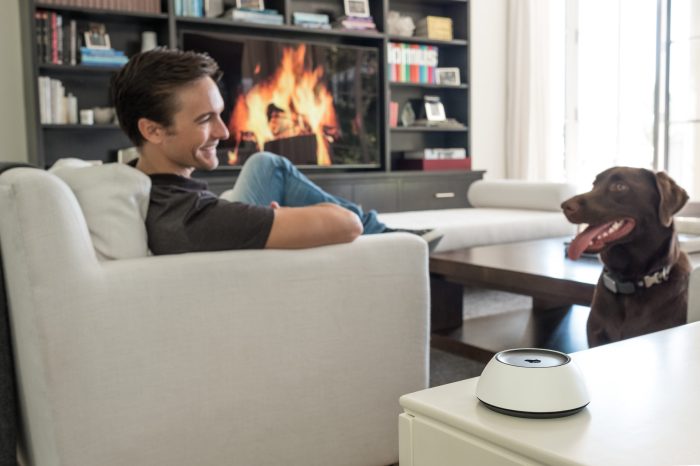
The voice-controlled home, once a futuristic fantasy, is rapidly becoming a reality. However, its evolution isn’t without its hurdles. Understanding the trajectory of this technology requires examining the interplay of rapidly advancing AI, persistent interoperability issues, and the ethical implications of increasingly pervasive voice assistants. This exploration will illuminate the path ahead for voice-controlled homes, highlighting both the immense potential and the critical challenges that must be addressed.
Advancements in AI and Their Impact
Artificial intelligence is poised to revolutionize the voice-controlled home experience. More sophisticated natural language processing (NLP) will lead to more nuanced and intuitive interactions. Imagine a system that not only understands your requests but also anticipates your needs, proactively adjusting the home environment based on your established routines and preferences. For example, AI could learn that you prefer a cooler temperature in the bedroom before bedtime and automatically adjust the thermostat accordingly, even without explicit instruction.
Machine learning algorithms will further personalize the experience, learning from user data to optimize energy consumption, security protocols, and entertainment preferences. This level of personalization will create a truly seamless and adaptive home environment.
Interoperability Challenges in Smart Home Ecosystems
A significant obstacle to widespread adoption is the lack of universal interoperability between different smart home devices and platforms. Currently, many devices and platforms operate in silos, hindering seamless integration and creating a fragmented user experience. A user might have a smart speaker from one company, lighting controlled by another, and a security system from a third, resulting in a complex and frustrating system that requires multiple apps and interfaces.
Achieving true interoperability necessitates the development of standardized communication protocols and open APIs, allowing devices from different manufacturers to communicate and work together harmoniously. The industry needs to move beyond proprietary systems and embrace open standards to foster a truly integrated smart home experience. Consider the scenario where a user wants to activate their security system upon leaving the house, using a voice command.
Currently, this might require multiple commands across several apps; a truly interoperable system would allow this to happen with a single command.
Predictions for Future Development and Adoption
The future of voice-controlled homes points towards greater integration, personalization, and accessibility. We can expect to see a significant increase in the adoption of voice assistants across all age demographics, driven by improved user interfaces and more affordable devices. Furthermore, voice control will become increasingly embedded within the fabric of the home, extending beyond simple commands to encompass sophisticated automation and proactive assistance.
For instance, imagine a home that anticipates your arrival, preheating the oven and adjusting the lighting based on your typical schedule. This level of sophistication is achievable with advancements in AI and the proliferation of interconnected devices. By 2030, we predict that voice control will be a standard feature in nearly all new homes, mirroring the widespread adoption of internet connectivity seen in recent years.
Ethical Considerations in Voice-Controlled Home Systems
The rise of voice-controlled homes raises significant ethical concerns. Data privacy and security are paramount. Voice assistants constantly collect data about user behavior and preferences, raising concerns about potential misuse or unauthorized access. The potential for algorithmic bias in AI-powered systems is another critical consideration. Biases embedded in training data can lead to unfair or discriminatory outcomes, potentially impacting access to services or creating skewed home environments.
Robust regulations and industry standards are necessary to ensure the responsible development and deployment of voice-controlled home technology, safeguarding user privacy and preventing discriminatory practices. Transparency and user control over data collection and usage are crucial aspects that need to be addressed.
Emerging Technologies Shaping the Future
The Internet of Things (IoT) and 5G networks are key drivers shaping the future of voice-controlled homes. The proliferation of interconnected devices provides a richer ecosystem for voice control, allowing for more sophisticated automation and personalization. 5G’s high bandwidth and low latency will enable seamless communication between devices, facilitating real-time control and responsiveness. Imagine a scenario where your voice command instantly adjusts the lighting, temperature, and entertainment system across multiple rooms simultaneously, without any noticeable lag.
This level of responsiveness is made possible by the increased speed and reliability of 5G networks. The combination of these technologies will create a more responsive, intelligent, and interconnected home environment.
Illustrating a Voice-Controlled Home Scenario
Imagine waking up in a home where technology anticipates your needs before you even voice them. This isn’t science fiction; it’s the reality of a voice-controlled home, a space where seamless integration of technology enhances comfort and efficiency. Let’s explore a typical day within such an environment.A Day in a Voice-Controlled HomeThe day begins subtly. As the sun rises, the smart blinds automatically adjust, letting in a gentle, natural light.
The smart thermostat, learning your preferences over time, already has the temperature set to your ideal waking temperature. A soft, pre-selected playlist starts playing through the integrated sound system, a calming melody to ease you into the day. A quick “Good morning, home,” triggers a concise weather report and traffic update tailored to your commute, all delivered through the central smart speaker.
Breakfast is prepared with minimal effort – a simple voice command initiates the smart coffee maker and toaster.
A Visual Description of a Modern Voice-Controlled Home
The home itself is a study in minimalist elegance. Neutral tones dominate the color palette, accented by the sleek lines of integrated technology. The walls appear seamless, with smart speakers subtly integrated into the architecture, almost invisible yet always present. Smart lighting subtly adjusts throughout the day, mimicking natural sunlight. A large, interactive touchscreen panel in the kitchen serves as a central control hub, displaying real-time information and offering intuitive control over various home systems.
Subtle, almost invisible sensors monitor movement and environmental conditions, ensuring optimal comfort and security. The overall aesthetic is one of calm sophistication, where technology blends seamlessly into the living space rather than dominating it. Smart appliances are integrated within custom cabinetry, maintaining a clean, uncluttered appearance.
Benefits and Drawbacks of Voice-Controlled Home Living
Living in a voice-controlled home offers significant advantages. Increased convenience is paramount; from automated lighting and temperature control to hands-free operation of appliances, daily tasks become effortlessly streamlined. Enhanced security features, including smart locks and surveillance systems, offer peace of mind. Energy efficiency is also a key benefit, as smart systems optimize energy consumption based on occupancy and usage patterns.
For example, lights automatically switch off in unoccupied rooms, and the heating adjusts based on the weather and your schedule. However, the reliance on technology also presents potential drawbacks. System malfunctions can disrupt daily routines, and the initial investment cost can be substantial. Concerns surrounding data privacy and security are also valid, requiring careful consideration of the security measures implemented.
Furthermore, a dependence on technology can create vulnerabilities in case of power outages or internet connectivity issues. The potential for technology to malfunction or become outdated necessitates a proactive approach to maintenance and upgrades.
Wrap-Up
The voice-controlled home isn’t just a technological marvel; it’s a paradigm shift in how we interact with our living spaces. While challenges remain – particularly concerning security and data privacy – the benefits are undeniable, promising increased convenience, accessibility, and a more intuitive home environment. As AI and IoT technologies continue to advance, we can anticipate even more sophisticated and personalized experiences, making the voice-controlled home a truly transformative force in the future of living.
The journey towards seamless home automation is underway, and the potential is limitless.

